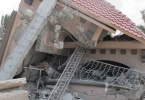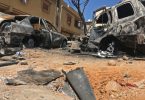The New York times
An on-the-ground examination by The New York Times of sites across Libya that were the targets of NATO airstrikes found evidence that the air campaign was not as flawless as NATO has described. The Times found credible accounts of dozens of civilians killed in several distinct attacks, of an attack on rebels and an ambulance that NATO explicitly denied, and of structures that seem to have been hit by mistake.
March 30 Surman
Destruction of Warehouses at a Former Plastic Factory
This factory had been defunct for some time. Its owner, neighbors said, used the factory’s warehouses for an import business and stored goods in them.
One pair of warehouses was struck by two bombs from allied aircraft early in the war, when the campaign was still under American command. Anti-Qaddafi guards now at the site, who live in the neighborhood, said they witnessed the strikes that night. They said they believed that ammunition had been stored on the site briefly, perhaps a month before the air war began, but had been moved, and that neither the factory complex nor its warehouses had a military presence or military equipment within.
The warehouses, now destroyed, held only canned tomatoes, they said. Now, the rubble in the open-air ruins of the place contained what these men said: stacks and bins of canned tomatoes.
No one was wounded in the attack, the guards said. But they were perplexed by the rationale for the strike. It was, by their account, an example of a bombing strike that relied on poor intelligence, dated intelligence or both.
June 20Surman
Destruction of a Post Office
The post office and a building next to it, both alongside a large communications tower, were destroyed. Beside them was a small residential building that was extensively damaged. The damage to the home seemed to have been caused by flying debris, not a direct hit.
Anti-Qaddafi fighters now occupy an undamaged building on the other side of the post office. They said the two destroyed buildings had been used by the Qaddafi military as a communications site. (Both sides in the war used public buildings, including schools, for military purposes.) The tower, two of them said, was connected to a command center at the home of a Qaddafi confidant, a major general, who lived a few blocks away and was also struck.
The anti-Qaddafi fighters said the damaged residential building had been occupied by a family, including a woman and a child. No one was killed in their apartment, but several rooms were destroyed and the family’s possessions ruined, these fighters said. The family moved away. Clothing, food and toys remained in the rooms. This strike appeared to have been a case of NATO striking a potentially legitimate military target but damaging adjacent civilian infrastructure.
June 20Surman
Destruction of a General’s Residential Compound
This gated compound included multiple houses, expansive gardens, bird cages and swimming pools. It was owned by the Hamedi family. Maj. Gen. El-Khweldi el-Hamedi, the patriarch, was a member of Colonel Qaddafi’s Revolutionary Council. In addition to the general’s residence, two of his sons — Mohammed and Khaled — had homes here.
NATO aircraft destroyed at least three homes, along with what appeared to be a service building and a tentlike structure on the compound’s western side. The strikes were direct hits — a deliberate attack that probably included delayed-fuze bombs. (Ordnance in several places seemed to have passed through concrete ceilings and upper rooms and exploded within, perhaps beneath the ground floor.)
Rebel fighters said the general and his sons were commanders directing operations in western Libya. The compound, two local fighters said, was connected by cable to a communications tower at a post office. Local anti-Qaddafi fighters said officers in the Qaddafi military visited the compound for meetings with the general.
The Hamedi family said these claims were fabrications. The general had retired, they said, and Khaled ran a charity. Their homes, they said, were occupied by women, children and the family’s staff members, a claim local anti-Qaddafi fighters confirmed.
By Khaled’s account, the family had celebrated the third birthday of Khweldi, one of his sons, hours before NATO attacked. Guests were sleeping when as many as eight bombs hit, turning homes to rubble, crushing those within.
The Qaddafi government used the strike for propaganda purposes. It claimed as many as 19 civilians were killed and put up portraits of the victims across Tripoli. Khaled offered a slightly different count, saying 13 civilians were killed and six wounded. Among the dead, he said, were his wife, two children and one of his nieces. Local anti-Qaddafi guards, who had no sympathy for the Hamedis, corroborated those deaths and said members of their families had seen the children’s bodies immediately after the attack. The other deaths could not be confirmed, in part because the victims and the family were scattered by the war.
General Hamedi survived and has sought refuge in Morocco. Khaled also survived. He filed a lawsuit against NATO in Brussels. “Hopefully, one day I will get justice,” he said by e-mail.
A wing of one ruined home bore signs of a bomb that did not explode. It passed through a reinforced concrete ceiling and floor, into the earth below. The Times provided photographs and the location to the Mines Advisory Group, a nongovernmental organization that was cleaning up unexploded munitions in Libya.





